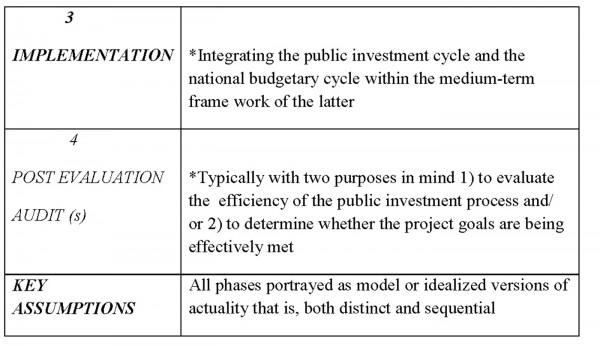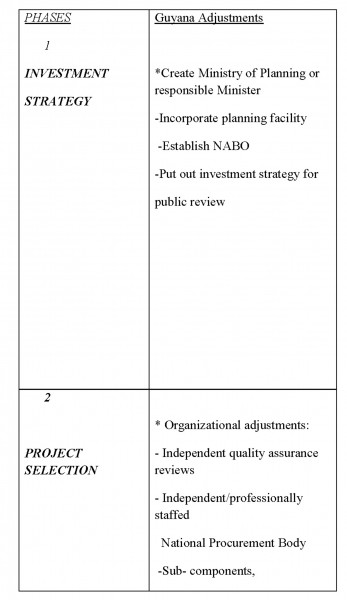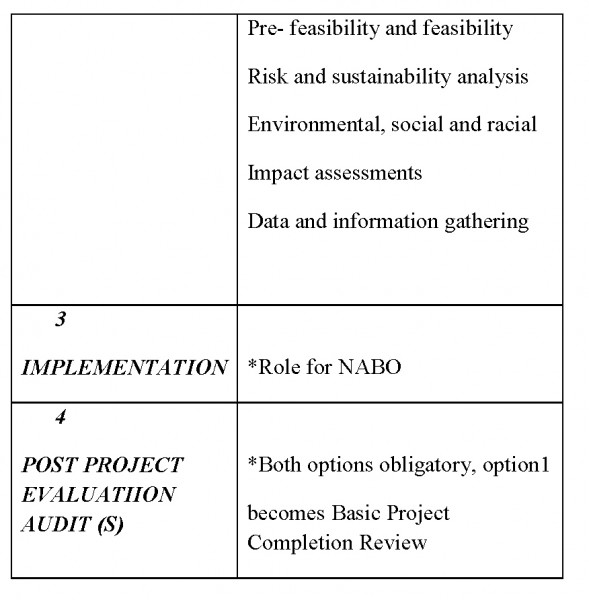As promised, this week’s column provides the second of a two-part lesson on the topic: organizing the management of Guyana’s public investment regime. The first part, which was presented last week, outlined the managerial process and highlighted what I indicated were the rudiments of a minimalist institutional structure. Reported studies  worldwide on this topic alternately label this as the “basic steps” or essential elements to be found in well-functioning public investment regimes. Schedule 1 below summarizes last week’s presentation, which could not be presented then due to lack of space.
worldwide on this topic alternately label this as the “basic steps” or essential elements to be found in well-functioning public investment regimes. Schedule 1 below summarizes last week’s presentation, which could not be presented then due to lack of space.
Schedule 1: “BASIC STEPS”
Source: Author, April 12 2015
Schedule 1 above displays the four basic phases of public investment management; the key assumptions used to identify these, as well as selected observations on each phase. My task this week is to suggest amendments to the basic steps indicated above in order to make them appropriate to Guyana’s circumstances. These suggested amendments are shown in Schedule 2 below.
For Phase 1 Guyana has neither Ministry of Planning nor autonomous or semi-autonomous planning body. It does however have good source documents; principal among these are the manifestos of the ruling and other parliamentary parties, Versions 1 and 2 of the civil society National Development Strategy (NDS 1996, 2000), several IFIs and Government of Guyana jointly prepared Poverty Reduction Strategy Papers (PRSPs 2001- 2015), the Low Carbon Development Strategy (LCDS 2008), the National Competitiveness Strategy (NCS 2006) plus sectoral and state enterprises plans (GPL, GuySuCo).
Despite this rich availability, for Phase 1 I recommend an adjustment by way of creating a ministry or minister responsible for planning, incorporating within the ministry a national planning body. This should be complemented with the establishment of a National Assembly Budget Office (NABO), along lines I have previously advocated. I recommend also that the investment strategy arrived at is routinely pre-screened by subjecting it to independent review before proceeding further to Phase 2.
For Phase 2, I recommend adjusting for three distinct sub-phases. These are 1) Quality assurance reviews of the economic analytics applied in the project evaluations; 2) Establishment of a professionally staffed national procurement body; 3) Organizational recognition of four distinct sub-components of Phase 2, namely, cost-saving through routine pre- screening of projects (pre-feasibility) before undertaking final studies, risk and sustainability analysis, environmental, social and racial impact assessments; and last, but not least, intense data and information gathering.
Schedule 2: Phases Adjusted for Guyana
Because of the lack of experience in Guyana Phase 3 should emphasize the interaction of the budget processes and those involved in project execution. This is a reciprocal endeavour in which NABO can play a major part from the parliamentary end. Here flexibility in adjusting to the fiscal and other budgetary demands is vital.
Finally, for Phase 4 I recommend that for all completed public investment projects their post project evaluation audits along the two optional lines shown in Schedule 1 should be adjusted so that both options are pursued so that the first option becomes what is now termed in the literature a Basic Completion Review.
The assumptions listed in Schedule 1 continue to apply.
Next week I present the third lesson, which focuses on Guyana’s public projects weaknesses arising from its abysmal record of public investment management.









